The ESSENTIALS of fitting horse gear
Apr 04, 2021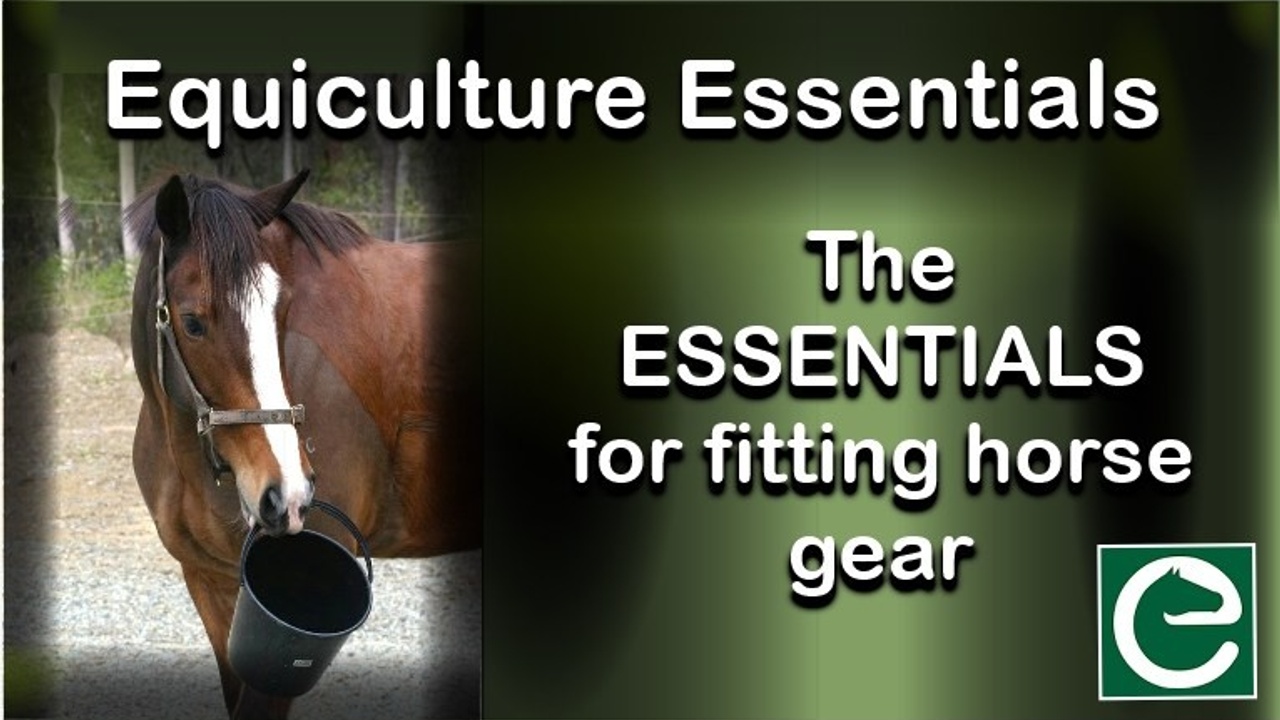
The correct selection and fitting of gear are essential if you want your horse to be relaxed and to work with you without discomfort or pain. A horse cannot go well in poorly fitting gear in the same way that you cannot walk in poorly fitting shoes or cope with clothes that are too tight etc.
Poorly fitted gear rubs and causes sore areas - leading to discomfort or even sharp pain in a horse; therefore, poorly fitting gear can start many physical and behavioural problems in horses. It is common for horses to be blamed for ‘bad behaviour’ when the poor horse is simply trying to avoid pain caused by poorly fitting gear.
An inexperienced owner/rider will need help when fitting new gear to a horse. Fitting gear, particularly a saddle, is complex until a horse owner is experienced enough to know exactly what to look for. Therefore if you are inexperienced or unsure, seek expert advice.
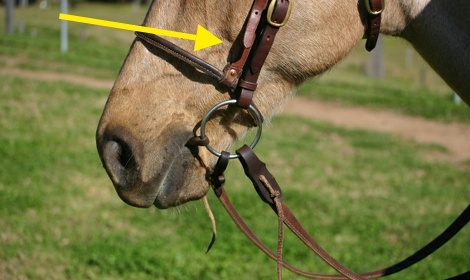
The bit is ideal, not too high or too low in the mouth. The noseband is not too tight and sits well below the protruding check bone (arrow).
Physical and behavioural signs that a horse is in pain from poorly fitted gear include:
Horses usually give many signs that they are in pain. Remember that horses do not make a noise (like a dog) when in pain. They suffer in silence, like most animals that are prey rather than preditors. This is because in the wild, making noise signals weakness to predators and means that they are more likely to be selected to hunt down.
Horses do not resist just to 'piss you off', or because they are 'trying it on' etc. They resist because they are in pain. If a horse has been in pain for a long time, they may show very few signs because they have learned that complaining does not get relief. There are various terms, but a horse can become 'shut down' if they have learned that resistance is futile.
Some of the typical signs that a domestic horse is in pain include:
-
Tender areas that may be felt when grooming.
-
Resistance to being saddled or bridled.
-
Reluctance to being caught.
-
Head tossing, bucking, rearing, napping.
In particular, the areas of the horse that are commonly affected by badly fitting gear are the mouth corners (due to problems with the bit), the base of the ears (due to problems with the browband), the front of the nose, and the back of the jaw (due to problems with the noseband), the area behind the elbow (due to problems with the girth) and the back area due to issues with the saddle cloth and/or due to incorrect saddle fit.
How to fit a bit to a horse
Poorly fitting and inappropriate bits cause many problems for horses. The bit should have no sharp edges, be the correct size for the horse, and be fitted at the correct height in the mouth.
Bits vary enormously in type and severity. Some bits are very severe and should not be used by an inexperienced horse person. At the same time, (ethical) knowledgeable horse people realise that severe bits are counterproductive and do not use them. Never use a bit without fully understanding how it works and why you are using it.
You should be able to get a finger between the mouth and the bit ring on each side. The bit should not be pulled up too tight. However, if it is too low, it will dangle in the horse's mouth and be uncomfortable.
Some people choose to ride bitless. There is an excellent worldwide organisation; if you would like to learn more - Welcome to World Bitless Association
How to fit a browband to a horse
The browband can be a source of discomfort if not fitted properly. If it is too tight, it can pull the headpiece (the strap that runs over the top of the head) too close to the ears, so check that it is not doing this. Horses that are uncomfortable due to an ill-fitting browband may shake their head or keep trying to rub the bridle off, although many horses show no outward signs even though the browband is too tight.
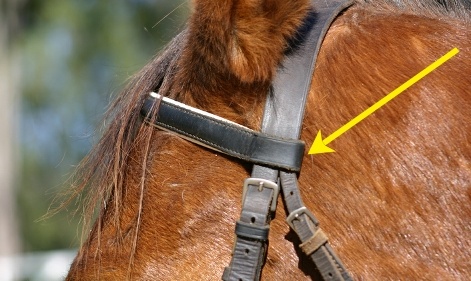
This browband is not pulling the headpiece of the bridle forwards (arrow), but if it were any shorter, it would do. When the browband is too short, the headband rubs the back of the (very sensitive) ears.
How to fit a noseband to a horse
A bridle may or may not have a noseband fitted. A noseband should not be tight around the nose/jaw of the horse. Unfortunately, it is very common to see nosebands that are far too tight. There should be room to fit two fingers between the noseband and the head.
Be especially careful with a young horse (up to five years old) that will have molars erupting in the jaw (‘tooth bumps’). These ‘tooth bumps’, which are the roots of the large molars protruding down through the jaw, disappear over time as the tops of the teeth wear down in the mouth, and the large molars continue to ‘erupt’ upwards into the mouth. They are not usually a problem other than they can become tender if a noseband is fitted too tightly. A too-tight noseband, in this case, will cause additional pain. A too-tight noseband, in this case, will cause additional pain.
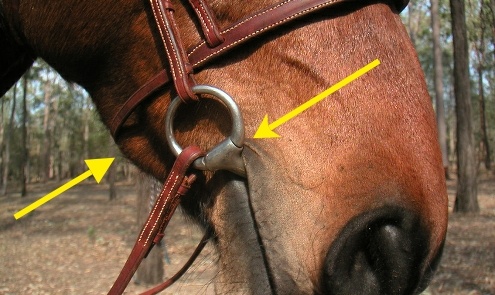
In this example, the bit is slightly too high in the mouth (even though creases in the mouth corners used to be regarded as correct - arrow). The noseband is correctly fitted but notice the ‘tooth bumps’ of this five-year-old horse (arrow), which can become painful if a noseband rubs them. In many cases, a noseband is not necessary.
Unfortunately, modern bridles tend to be sold with a complicated noseband designed to keep the horse's mouth closed (rather than a simple 'cavesson' noseband) as standard. This means that people often use them when they are unnecessary.
An inexperienced rider should not use nosebands that fasten the mouth shut, yet they often are. The reason for using them is to prevent the horse from evading the bit. If a horse is evading the bit, it is usually because the bit hurts, the horse has sharp teeth, the rider is too heavy-handed/inexperienced, or the horse has not been taught how to ‘accept’ the bit properly (or a combination of these factors).
The International Society for Equitation Science has developed a Noseband Taper Gauge for stewards of competitions to use to check the tightness of nosebands before horses enter the ring - www.equitationscience.com/store/taper-gauge
If you are involved with a pony club/riding club, why not suggest they buy a couple of these inexpensive gadgets?
This is not an affiliate link - just recommending it because I think they are a great idea.
How to fit a girth on a saddle
A girth should be the correct length and not rub (which will cause girth galls/pressure sores). The material that a girth is made from can lead to rubbing, as can a build-up of dirt on the girth and/or the horse.
When a horse has been out of work for some time, girth galls are more likely to occur when the horse returns to work due to the skin in this area becoming softer (this, of course, also applies to young horses who are starting work for the first time), in the same way that blisters initially form on your hands and feet if you do unaccustomed hard physical work.
A girth that is too tight or loose can also cause girth galls (too tight causes too much pressure, and too loose can move around and rub).
A girth should ideally fit when on the middle holes of the girth straps so there is room for expansion and contraction as the horse changes condition.
Modern girth materials tend to work well and are easier to keep clean - an important consideration when you consider that girth galls can be caused by dirt. Modern girths also tend to have some elasticated properties, which are good.
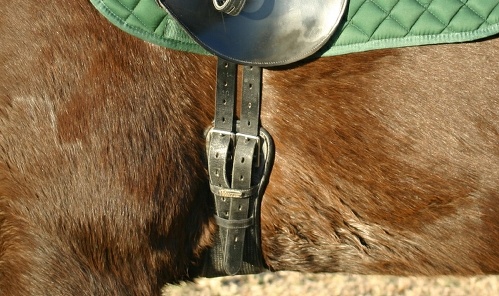
A girth should ideally fit when on the middle holes of the girth straps so that there is room for expansion and contraction as the horse changes condition.
How to fit a saddlecloth, numnah or saddle blanket
A saddlecloth, numnah or saddle blanket can keep the underside of the saddle clean and soak up or wick away sweat. Synthetic saddles should always have something underneath them because they create a lot of heat. Western saddles must always be used with a thick pad because the saddle does not have padded panels.
Make sure that the saddle cloth is pulled up into the gullet of the saddle before the girth is fastened. Otherwise, the saddlecloth will pull tight over the withers and cause a sore. Once the girth is fastened, check that the saddle cloth has not been pulled down tight over the withers.
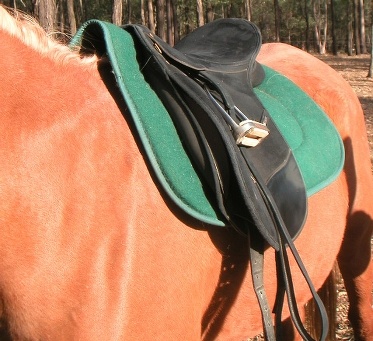
Make sure that the saddle cloth is pulled up into the gullet of the saddle before the girth is fastened. Otherwise the saddlecloth will pull tight over the withers and cause a sore spot.
How to fit a saddle
A poorly fitting saddle causes many problems because the weight of the rider exacerbates poor saddle fit. A saddle can be too narrow in the 'tree' (the internal frame of the saddle), which will pinch the horse’s back, or too broad (which will cause the saddle to put direct pressure on the bones of the horse’s back). A saddle can be too short - which will concentrate the weight of the rider into an area that is too small or too long - which will put the rider's weight over the weakest part of the horse’s back - near the loins.

This saddle is the correct length for the horse’s back, neither too short nor too long. The excellent quality thick saddle ‘pads’ shown here are needed under this style of saddle because it does not have padded panels like ‘English’ saddles.
Remember that a horse changes shape as they lose or gain condition (fat and muscle). For example, a saddle fitted to a four-year-old horse will not necessarily fit that same horse after a year of work because the horse will have developed muscle that will cause the back to change shape.

Two other areas for concern with a saddle are that the pommel should sit well above the withers and that a hand should be able to be run down between the saddle and the shoulder, each mirroring the other, i.e. your hand should not feel more or less pressure as it moves downwards.
If possible, a saddle should always be fitted by a professional saddle fitter. Saddlery stores often provide this service. If not, your riding instructor, Pony Club, or local riding club should be able to help with gear fitting in general. In fact, why not suggest to your club that you have a gear fitting day and get an expert to teach the members?
The welfare issues of horse gear
In this age of enlightenment, many people talk of having a better ‘partnership’ with their horse, yet this is often not reflected in the harsh gear and gadgets they use. It is a good idea to evaluate your equipment from time to time and check that you are not using harsh gear simply because it is fashionable to do so (peer pressure) or because you do not know any different.
This article is a quick guide to fitting gear and covers some of the more essential points. Please always get expert help with fitting gear - it is crucial that your horse is as comfortable as possible.
If you enjoyed this article, check out the others on the blog. Also, make sure you sign up for the free mini-course called Horses, Pasture and Grazing and the free 23-page PDF called 10 common POSITION and BALANCE checks for riders

















